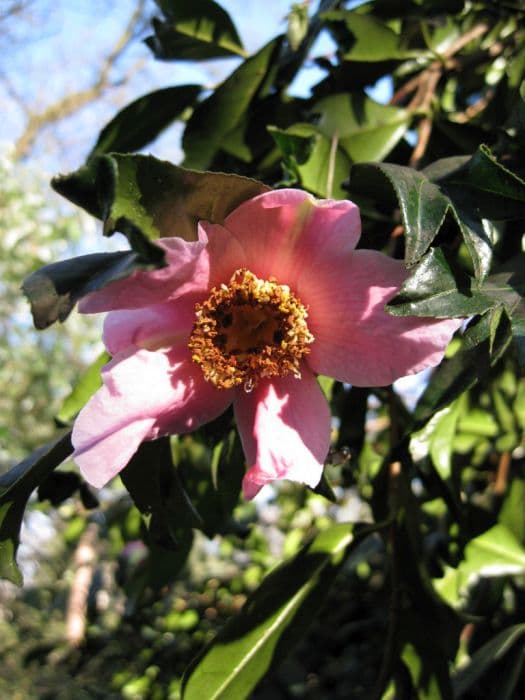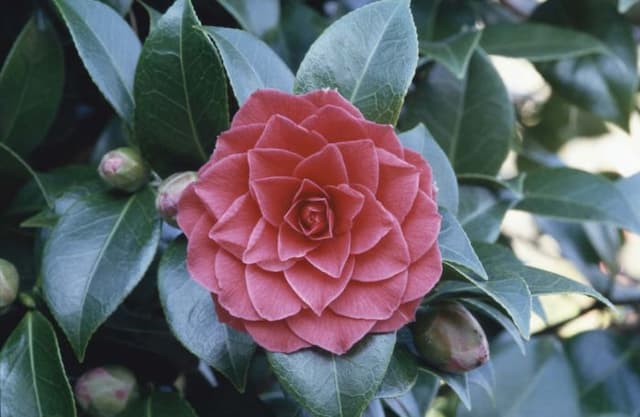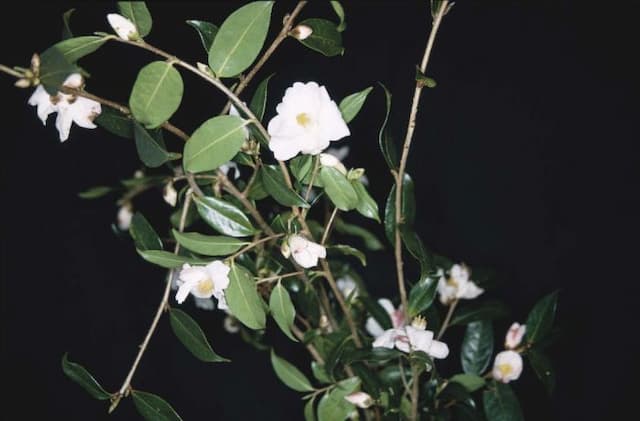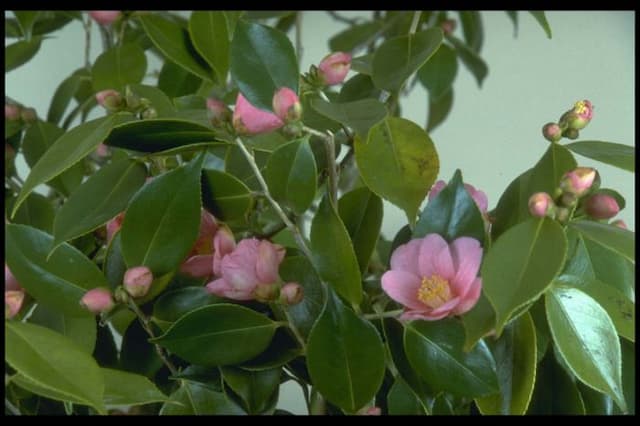Williamsii Camellia Camellia × williamsii 'C.f. Coates'

ABOUT
The Camellia × williamsii 'C.f. Coates', commonly known as the Camellia, is a plant with a visually captivating appearance. It is characterized by lush, glossy, evergreen leaves that provide a year-round display of rich green foliage. The leaves are oval-shaped with a slightly serrated edge, adding to the plant's overall texture. The true stars of the show are the flowers which can be quite spectacular. These blooms typically present in shades ranging from pink to deep rose, often with a hint of coral depending on the particular cultivar. The flowers are large and showy, with a classic camellia form that includes a multitude of overlapping petals, giving them a full and ruffled look. At the center of each flower, contrasting yellow stamens often create a striking visual focal point against the richly colored petals. Flowering mainly in the cooler months, the Camellia provides a burst of color when many other plants are dormant. Its blooms not only enhance garden aesthetics but are also attractive to garden visitors such as bees and other pollinators. The visual appeal of Camellia 'C.f. Coates' makes it a popular choice for ornamental planting, turning any garden into a picturesque display of vibrant colors and elegant form.
About this plant
 Names
NamesFamily
Theaceae.
Synonyms
Williams' Camellia, Hybrid Camellia, Coates' Camellia.
Common names
Camellia × williamsii 'C.f. Coates'.
 Toxicity
ToxicityTo humans
The Camellia, specifically the hybrid Camellia × williamsii 'C.f. Coates', is not considered toxic to humans. There are no well-documented cases of poisoning from ingesting parts of this plant. Therefore, it is generally regarded as safe, and no symptoms of poisoning are expected from contact or ingestion under normal circumstances.
To pets
Similar to its effects on humans, the Camellia is not known to be toxic to pets either. The hybrid Camellia × williamsii 'C.f. Coates' should not cause any adverse symptoms if ingested by pets such as dogs or cats. It is considered safe, and there are no particular consequences anticipated from pets consuming parts of this plant.
 Characteristics
CharacteristicsLife cycle
Perennials
Foliage type
Evergreen
Color of leaves
Green
Flower color
Pink
Height
6-8 feet (1.8-2.4 meters)
Spread
6-8 feet (1.8-2.4 meters)
Plant type
Shrub
Hardiness zones
7-9
Native area
Asia
Benefits
 General Benefits
General Benefits- Ornamental Value: Produces large, showy flowers that enhance the aesthetic appeal of gardens.
- Long Blooming Period: Offers a long-lasting display of blooms from late winter to early spring.
- Evergreen Foliage: Provides year-round greenery and structure in the garden.
- Cold Tolerance: Capable of withstanding cooler temperatures, making it suitable for a variety of climates.
- Low Maintenance: Requires minimal pruning and care once established.
- Drought Resistance: Can tolerate periods of dry conditions after becoming established.
- Versatility: Can be used in various landscape designs, including formal gardens, woodland settings, and as specimen plants.
- Attracts Pollinators: Flowers are attractive to bees and other pollinating insects, supporting local ecosystems.
- Diverse Cultivars: Available in a range of flower colors and forms to suit different garden themes and preferences.
- Shade Tolerance: Can grow in partially shaded areas, offering flexibility in garden placement.
 Medical Properties
Medical PropertiesThis plant is not used for medical purposes.
 Air-purifying Qualities
Air-purifying QualitiesThis plant is not specifically known for air purifying qualities.
 Other Uses
Other Uses- Dye Production: The flowers of Camellia x williamsii 'C.F. Coates' can be used to produce natural dyes for fabric, offering a range of subtle hues depending on the mordant used.
- Fish Food: The fallen flowers can serve as a supplemental food source for carp and koi in ornamental ponds, providing both nutrition and aesthetic appeal.
- Compost Material: The spent blooms and leaves can be added to compost piles where they decompose and contribute to a nutrient-rich soil amendment.
- Craft Materials: Dried flowers can be incorporated into potpourri mixes or used to decorate wreaths and other craft items for a touch of natural beauty.
- Photography Subject: The striking flowers can be used in floral photography for commercial use or as a hobby, capturing the beauty through the lens.
- Flavoring Agent: Though not widely known, some parts of the camellia plant can be experimented with in culinary arts to provide floral undertones in desserts and beverages.
- Insectary Plant: Planting Camellia x williamsii 'C.F. Coates' in the garden can attract beneficial insects, which help in pollination and the control of pests.
- Water Conservation: The thick mulch made from the leaves can help in retaining soil moisture and protecting plant roots, thereby reducing water usage in the garden.
- Educational Tool: The plant can be used in botanical studies and horticultural education to illustrate hybridization and plant breeding techniques.
- Floral Arrangements: Fresh or dried, the flowers can be used in floral arrangements, bringing elegance and longevity to bouquets and centerpieces.
Interesting Facts
 Feng Shui
Feng ShuiThe Camellia is not used in Feng Shui practice.
 Zodiac Sign Compitability
Zodiac Sign CompitabilityThe Camellia is not used in astrology practice.
 Plant Symbolism
Plant Symbolism- Adoration: Camellia flowers often symbolize adoration and are given to someone who is admired.
- Perfection: Its perfectly formed petals represent the ideal of perfection and excellence.
- Long-lasting Devotion: Camellias are often associated with the eternal aspect of love, indicating a commitment that endures.
- Affection: The camellia flower is frequently presented to express genuine, heartfelt affection towards someone.
- Admiration for Beauty: Because of its own beauty, the camellia is a symbol of the beauty recognized in others.
 Water
WaterThe Williamsii Camellia should be watered thoroughly, ensuring that the soil is moistened deeply but without waterlogging. It is best to water this plant with about 1 gallon of water per week during growing season, but the frequency may need to be adjusted depending on climate and soil drainage; more often in dry conditions and less during rainy periods. Always check the top inch of soil for dryness before watering again. During winter, reduce watering but do not let the soil dry out completely.
 Light
LightThe Williamsii Camellia thrives best in partial shade, sheltered from the hot afternoon sun. An ideal spot would be under the canopy of tall trees that provide dappled sunlight or on the east or north side of a building where it can receive bright, indirect light without being exposed to harsh midday sun.
 Temperature
TemperatureThe Williamsii Camellia prefers a temperate climate with temperatures ideally ranging between 40 and 75 degrees Fahrenheit. It can withstand occasional dips below 32 degrees Fahrenheit but should be protected from prolonged exposure to freezing temperatures. Heat above 85 degrees Fahrenheit can stress the plant, so it should be positioned in a cool, shaded area during hot summer months.
 Pruning
PruningPrune the Williamsii Camellia to maintain shape, remove dead or weak wood, and encourage bushier growth. The best time for pruning is just after blooming in spring, as camellias set next year's buds soon after the current blooms fade. Typically, annual pruning is sufficient, but it may be skipped if the plant maintains a good shape naturally.
 Cleaning
CleaningAs needed
 Soil
SoilWilliamsii Camellia prefers acidic soil with a pH between 5.0 and 6.5. The best soil mix should be well-draining and rich in organic matter. Combine equal parts of ericaceous compost, pine bark, and peat moss to create an ideal medium for this plant.
 Repotting
RepottingWilliamsii Camellia should be repotted every 2-3 years. It's best to repot in the late winter or early spring before new growth starts, using the aforementioned acidic soil mix.
 Humidity & Misting
Humidity & MistingWilliamsii Camellia thrives at moderate to high humidity levels, ideally between 50-70%. Avoid placing it in excessively dry conditions as it may lead to leaf scorch or bud drop.
 Suitable locations
Suitable locationsIndoor
Place in bright, indirect light with high humidity.
Outdoor
Partial shade, sheltered from wind, acidic soil.
Hardiness zone
7-9 USDA
 Life cycle
Life cycleThe Camellia x williamsii 'C.F. Coates', commonly known as the Williamsii camellia, begins its life as a seed, which germinates to produce a small seedling. The seedling stage is characterized by the emergence of the first set of true leaves after the seed leaves (cotyledons). As it enters the vegetative stage, the camellia grows new leaves and branches, forming a bushy shrub. During its maturity phase, it develops flower buds that bloom into large, colorful flowers, typically in winter to spring. Post-bloom, fertilized flowers may produce seed pods, completing the reproductive cycle. The plant continues to grow and cycle through seasonal bloom and dormancy years, often living for several decades with proper care.
 Propogation
PropogationPropogation time
Late winter-early spring
Propogation: Camellia × williamsii 'C.f. Coates', commonly known as Coates Camellia, is most commonly propagated through semi-hardwood cuttings. This technique involves taking cuttings from the plant during the late summer when new growth has begun to mature and harden slightly. Typically, cuttings should be about 4 to 6 inches long and include several sets of leaves. The lower leaves are removed, and the cut end is dipped in rooting hormone before being placed in a well-draining medium such as a mix of peat and perlite. The cuttings are then kept in a humid environment with indirect light at a temperature of about 70°F (21°C). Roots usually develop within several weeks, after which the new plants can be gradually acclimatized to less humid conditions before being potted on and ultimately planted out.









